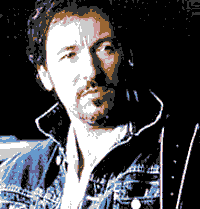
From the Chicago Tribune: ROCK 'N' ROLL REFLECTIONS
The long run with Springsteen
Bruce is The Boss of the road and our dreams
By Louis P. Masur, William R. Kenan Jr. Professor of American Institutions and Values at Trinity College
Published August 21, 2005
Thirty years ago, Bruce Springsteen's album "Born to Run" thundered onto the American scene to remarkable reviews. Greil Marcus of Rolling Stone declared "You've never heard anything like this before, but you understand it instantly, because this music ... is what rock 'n' roll is supposed to sound like."
In The New York Times, John Rockwell praised the songs as "poetry that attains universality. ... You owe it to yourself to buy this record." Robert Hilburn of the Los Angeles Times would later observe that "`Born to Run' breathed with the same kind of discovery that made Elvis Presley's `Sun Sessions' and Bob Dylan's `Highway 61 Revisited' the two most important American rock albums before it."
The album immediately elevated Springsteen to a cultural icon, and he was hailed as the savior of rock 'n' roll. That October, he appeared on the covers of Time and Newsweek during the same week, and his image--laughing, scruffy, guitar pointed ever upward--perfectly reinforced the message of his music: Life is a continuous journey in search of salvation and love.
On the album cover, a smile lights up Springsteen's face as he leans on his saxophonist Clarence Clemons, whose image carries over to the back. Attached to his guitar strap is an Elvis Presley fan club pin. Springsteen once observed that Presley freed our bodies and Dylan freed our minds. For my generation, Springsteen freed our souls.
I turned 18 in 1975, when Presley was a Vegas lounge act, and the rock revolution ushered in by Dylan's appearance at the Newport Folk Festival and the recording of "Like a Rolling Stone" was a decade in the past. Bruce belonged to us; we were part of the legend from the start. No more older siblings bragging that they saw the Beatles at Shea Stadium or attended Woodstock. I first heard Bruce in 1973, and I followed him and the band to clubs and small theaters, where I soaked in long sets that left me feeling exhilarated.
"Born to Run" gave voice to my dreams of escape and search for meaning. Of course, taking to the road to find yourself is a classic American theme. Bruce and Clarence on the cover are part of a cultural history that includes Herman Melville's Ishmael and Queequeg at sea or Mark Twain's Huck and Jim lighting out for the territory. But each generation conducts its search in its own way and out of its own imperatives.
Mine was something of a post-heroic generation, too young to have participated fully in the cultural rebellions of the 1950s and the civil rights and anti-war movements of the 1960s, yet socialized and politicized by those impulses and seeking direction. Richard Nixon resigned, the Vietnam War ended, and I ached to get away from home. Somehow, national and personal malaise mixed.
In the opening track, "Thunder Road," Springsteen sings "So you're scared and you're thinking that maybe we ain't that young anymore." The line was written by a 24-year-old, and it resonated among teens who feared what all youth fear: boredom, emptiness, meaninglessness. Redemption and love were to be found out on the road, away from "a town full of losers." "Climb in," the narrator insists, "I'm pulling out of here to win."
The song "Born to Run" opened the second side of the album. In this day of single downloads and sideless CDs, it is worth remembering that the best albums of the 1960s and 1970s had movement and drama: We listened to all the cuts and thought about the sequence. Those first few notes invite us on a journey to "get out while we're young" from a town that is "a death trap," "a suicide rap." Suburban comfort and social conformity sapped the soul. "Tramps like us, baby we were born to run," Springsteen declares. The chugging guitar and pounding bass lead us away.
He is striking the same cultural chords as any number of artists: Walt Whitman, Charlie Chaplin, Woody Guthrie and Jack Kerouac, to name a few. But Springsteen has made the highway and the American dream his own. The recording, which took three months in the studio to get pitch perfect, still sounds immediate and vital. Asked recently to identify the one song that embodies his ideals, Springsteen named "Born to Run."
If "Thunder Road" and "Born to Run" offer promises of escape, others songs are less hopeful. Springsteen understands that tragedy stands alongside triumph as a central riff in American culture. On "Backstreets," the summer is "infested," and the characters are "filled with defeat." In "Jungleland," "the street's on fire in a real death waltz," and "lonely-hearted lovers struggle in dark corners."
The themes of love and heroism are reprised throughout, in the poetic words and the soaring arrangements. Those themes re-emerged with new poignancy on Sept. 11, and Springsteen was struck by the references to his work in the Times' "Portraits of Grief." After the service for one victim, mourners sang "Thunder Road" and remembered their friend who "taught us all a lesson in unconditional love." I wonder how many of my generation have left instructions, as I have, for Springsteen to be played at their funeral services.
We may not find everlasting love, and we may turn out not to be heroes. Each of us is "a scared and lonely rider" seeking connection.
"Born to Run" ponders whether somewhere out there "love is wild, ... love is real" and if we keep searching we may eventually "get to that place where we really want to go and we'll walk in the sun." Until then--and pump your fist as you shout it--baby we were born to run.
No comments:
Post a Comment